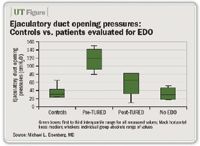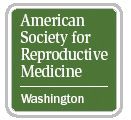Article
Novel test diagnoses ejaculatory duct obstruction
A novel modification of the Whitaker test using ejaculatory duct manometry shows promise for the diagnosis of ejaculatory duct obstruction.


"We believe the issue is seminal vesicle dysfunction," Dr. Eisenberg said. "The seminal vesicle acts a lot like a bladder, and can have problems similar to bladder dysfunction. This opens the door for 'functional' obstruction, causing EDO. Our hypothesis was that, similar to urodynamics, we could perform 'vasodynamics' on the male reproductive tract to better define and characterize EDO."

"Based loosely on the Whitaker test for ureteropelvic junction obstruction, we developed a method to measure ejaculatory duct opening pressures. First, the seminal vesicle is cannulated with ultrasound guidance and connected by IV tubing to the manometer. We fill the seminal vesicle with methylene blue and monitor the ejaculatory duct orifices cystoscopically for overflow, which suggests the system is filled. The pressure in the system is then transmitted to our manometer," Dr. Eisenberg explained.
A validation experiment confirmed correlation between IV tubing manometry and machine manometry.
Testing the test
The prospective cohort study involved a control group of seven fertile men undergoing vasectomy reversal and nine men with infertility or ejaculatory pain in whom EDO was suspected. Seven of these EDO patients presented with low-volume ejaculate and azoospermia or asthenospermia; two patients had pain. Mean seminal vesicle width was 16.5 mm for the patients with suspected EDO.
In both cohorts, ejaculatory duct manometry was performed under anesthesia. Opening pressures were measured transvasally in controls and transrectally (via the seminal vesicle) in EDO patients. The patients then underwent TURED, after which their pressures were re-measured by manometry, compared to controls, and correlated with response to TURED.
Dr. Eisenberg and colleagues determined that controls had a mean opening pressure of 33 cmH2O and fell within a narrow range of measurements. Patients suspected of EDO prior to TURED had a significantly higher mean pressure of 116 cmH2O and a wide range of pressures. After TURED, their mean opening pressure dropped to 54 cmH2O (p<.01). Patients who were found intraoperatively not to have EDO had a mean pressure of 33 cmH2O, the same as controls, Dr. Eisenberg reported.
TURED was performed on six of the nine patients with suspected EDO; in three of the six cases, only a hemi-TURED was needed to relieve obstruction. One of these patients had general bilateral absence of the vas deferens and unilateral seminal vesicle agenesis, and could not give an ejaculated sample. Four of the remaining five patients (80%) demonstrated improvement in ejaculate volume and sperm count. Mean ejaculate volume improved from 0.7 to 2.7 mL, and total motile sperm count improved >100%.
"Fertile men have remarkably consistent and low ejaculatory duct opening pressures, while patients with EDO have significantly higher opening pressures," Dr. Eisenberg reported. "These can be lowered to the range of fertile controls with TURED and relief of obstruction."
Further, the novel ED manometry ap-proach proved feasible and reliable. "Given the complexity of this diagnosis," he said, "ED manometry has excellent potential to be able to delineate physical from functional obstruction."
Marc Goldstein, MD, professor of urology and reproductive medicine, Weill Medical College of Cornell University, New York, suggested that ED manometry could be a simple, useful modality to employ in infertile men in whom EDO is suspected.
"EDO is a vexing condition to diagnose, and it is hard to distinguish between partial and complete obstruction. ED manometry adds a more accurate means," Dr. Goldstein said, noting that the test's simplicity is also a benefit.
"The manometer is just a pipette attached to a piece of IV tubing," he said. "By looking at the level of water in the tubing, you determine the pressure. This is a nice, direct method that is similar to the Whitaker test we use for ur-eteropelvic junction obstruction. The test is readily available."
For his research, Dr. Eisenberg received the Society for Male Reproduction and Urology Prize Paper and the In-Training Award for Research.





